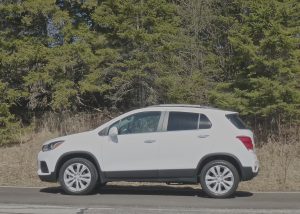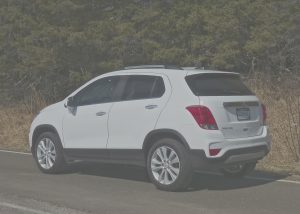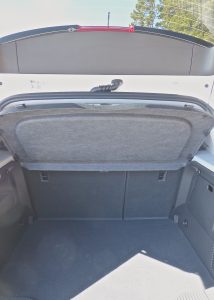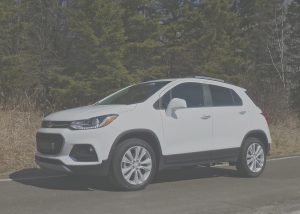Chevy makes Trax to fill compact SUV segment
By John Gilbert
If you are a cynic, or a hard-core traditionalist, you might view the Chevrolet Trax with some degree of scorn. I mean, for comparison sake, you have the Suburban, Tahoe, Equinox, Traverse, and assorted sizes of pickup trucks, and next to them, the Trax seems almost toy-like.
In that frame of mind, you might look with careful scrutiny to find things that are objectionable about the Trax, which is Chevrolet’s smallest, lightest, and probably least-haul vehicle. And yes, it’s inexpensive, in the mid-$20,000 range, but it’s got a tiny engine, so what good is it?
However, in real life you can try to find fault in the size, but once you climb inside you find that there is a surprisingly adequate amount of room, both in the front buckets and the rear seats. It doesn’t seem that anything that compact on the outside can be that roomy inside.
You can’t find fault with the instrument layout or the fit and finish of the dashboard or controls. In fact, they all seem laid out to perfection.
And when it comes to design, the Trax looks good from the front, especially with that little ring of LED driving lights that outline the headlight enclosures. It looks good from the rear, with a nicely proportioned taper to the hatchback and rear corners, as they slope upward toward the roof.
It also looks good in silhouette, rounded off nicely and proportioned just right all along the lines that sweep from stem to stern.
The Trax is the brainchild of General Motors when it went over to South Korea and bought out the Daewoo factory, which had made stylish but marginal cars that were faltering in the marketplace, particularly alongside such outfits as Hyundai and Kia.
The first Trax caught my attention, because I have always thought that any vehicle that’s big enough needn’t be bigger, and unless you have to haul a heavy trailer around, or make frequent trips with half a dozen or so occupants, then anything bigger than big enough is too big. Why should we haul around excess weight?
So the latest trend toward compact crossover SUVs was instantly appealing to me, and I appreciate nearly all of the dozens of downsized, economical and agile performers amid the sea of crossover vehicles. But the Trax still is mind-blowing when it takes its place in Chevrolet’s arsenal of medium to enormous SUVs.
 Then along comes the 2017 model year, and Chevrolet redesigns the Trax. It’s not an all-car, but what they cal“refreshed” in the industry. Meaning the corners might be rounded off, the contours tweaked just a bit, and everything sort of tightened up.
Then along comes the 2017 model year, and Chevrolet redesigns the Trax. It’s not an all-car, but what they cal“refreshed” in the industry. Meaning the corners might be rounded off, the contours tweaked just a bit, and everything sort of tightened up.
In the process, Chevrolet also upgraded the interior considerably, and what might have seemed a bit tacky in the original is now nicely padded and soft to the touch, as well as fitting together better.
Under the hood, there beats a 1.4-liter 4-cylinder engine with a turbocharger mounted, for crying out loud. There is no optional engine, but the Trax doesn’t need one. Chevrolet seems to have connected on the perfect group-think in plotting out the engine that will make the Trax perform the best, in either front-wheel drive or the all-wheel drive that folks in the snow-belt or who might face some foul weather should demand.
I had the chance to spend a week with a gleaming white Trax, and I thought it looked good in all circumstances. It also performed well on a freeway trip, and delivered fuel economy in the high 20s. EPA estimates range into the 30s, in fact, and you might reach the estimated 34 if you stayed under 65 or 70.
Among the new features are a Premier trim level, which offers larger 18-inch wheels with your all-season tires, and Apple CarPlay or Android Auto are now compatible, boosting the Trax to the properly high level of connectivity.
Lane departure warning and forward collision alert are now available, too, and, going back to the cynical big-truck guys, there can be no faulting the quickness of acceleration or the quick response of the steering, which is well-coordinated with the suspension.
There is no recommended towing capacity for the Trax, although you might get away with a light fishing boat or extra light camping trailer with the AWD models.
Trax continues to be a made-in-Korea vehicle, which is not an issue for anyone this side of our new president. And for anyone who has driven anything by Hyundai or Kia in recent years, we won’t question the technology or quality control of the Trax.
In fact, there are reports that the Trax has made its own impact on the new smaller compact-crossover segment by becoming the vehicle with a Chevrolet bow-tie emblem that is sold to the largest percentage of female buyers. Some estimates range as high as 60 percent female buyers, in fact, proving that women might be wiser than some of those cynical, macho types who think trucks have to be huge, hefty, poor in fuel efficiency, and twice as expensive as the basic $22,000 Trax.
The facts that it’s highly maneuverable, quick, attractive, and with all the improvements packed into the 2017 model make it worth evaluation for anyone looking for the security of weather-worthy AWD in a contemporary and high-style Trax.






 John Gilbert is a lifetime Minnesotan and career journalist, specializing in cars and sports during and since spending 30 years at the Minneapolis Tribune, now the Star Tribune. More recently, he has continued translating the high-tech world of autos and sharing his passionate insights as a freelance writer/photographer/broadcaster. A member of the prestigious North American Car and Truck of the Year jury since 1993. John can be heard Monday-Friday from 9-11am on 610 KDAL(www.kdal610.com) on the "John Gilbert Show," and writes a column in the Duluth Reader.
John Gilbert is a lifetime Minnesotan and career journalist, specializing in cars and sports during and since spending 30 years at the Minneapolis Tribune, now the Star Tribune. More recently, he has continued translating the high-tech world of autos and sharing his passionate insights as a freelance writer/photographer/broadcaster. A member of the prestigious North American Car and Truck of the Year jury since 1993. John can be heard Monday-Friday from 9-11am on 610 KDAL(www.kdal610.com) on the "John Gilbert Show," and writes a column in the Duluth Reader.